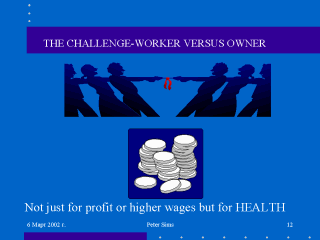| front |1 |2 |3 |4 |5 |6 |7 |8 |9 |10 |11 |12 |13 |14 |15 |16 |17 |18 |19 |20 |21 |22 |23 |24 |25 |26 |27 |28 |29 |30 |31 |32 |33 |review |
 |
Previously
Industrial relations were portrayed as a series of endless tugs of war between the
employer and the worker, the owner and the trade union. This model is inappropriate for the new world of work. Union power is most effective in the large factory or by exerting huge pressures on national governments by essentially closing down essential services-docks, railways, power, communications…………….... Management is most powerful in the Japanese car industry where the employee becomes a company man, with a company house, a company car,and takes his rest and recreation in the company’s sports grounds, swimming baths and entertainment complex.He trades freedom for security and a cocoon of protection……………... In the former Occupational Health was a right to be fought for alongside better working conditions, shorter hours and more pay. In the latter it was another perquisite (perk) for the job and might include annual executive health checks and free private medical care for employee and dependents. In today’s world there is a mixed economy-large firms, multinationals, nationalised industries,small private employers,still a few migrant workers and more self employed..it has to be co-operation and not conflict for work and for health. |